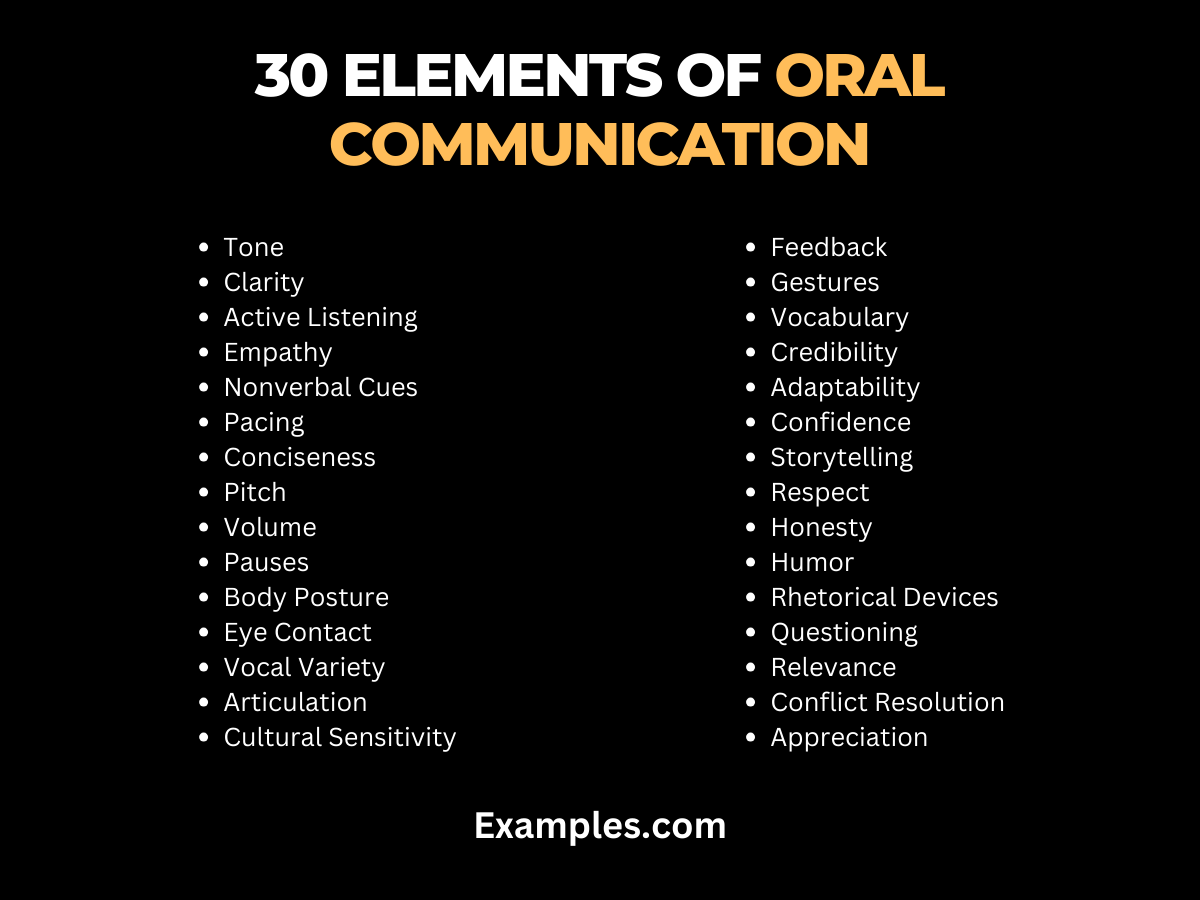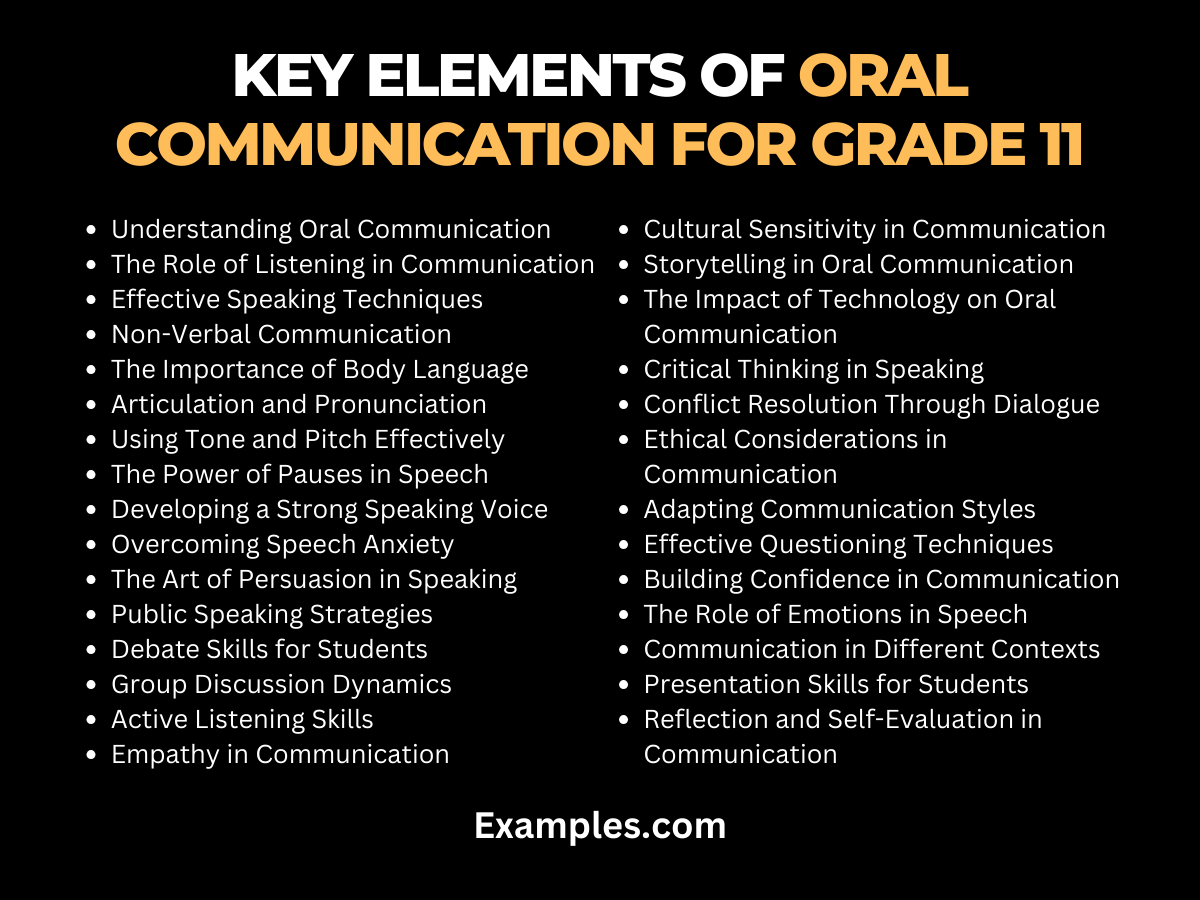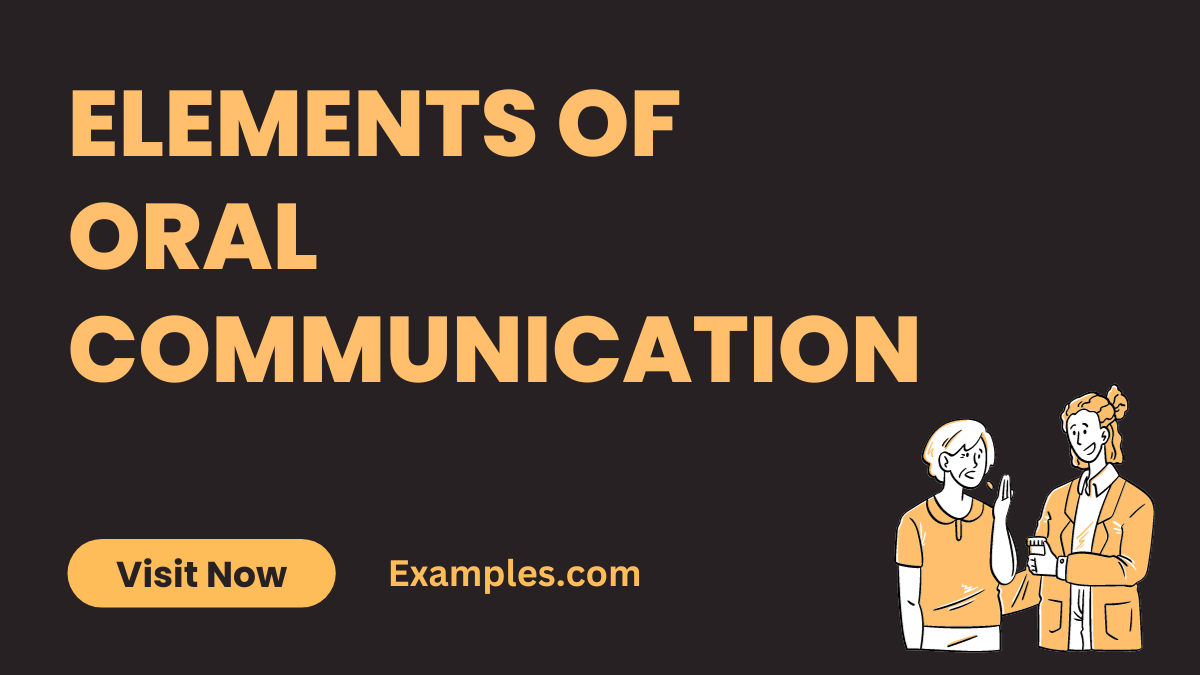30 Elements of Oral Communication Examples
Oral communication is a fundamental aspect of human interaction, essential in both personal and professional contexts. This comprehensive guide delves into the Elements of Oral Communication, offering insightful examples and practical tips. Whether you’re a student honing your skills for academic success or a professional seeking to enhance workplace communication, understanding these elements is crucial. From the basics of active listening in Oral Communication to mastering the art of public speaking in Oral Communication, this guide covers it all. We’ll explore various components, techniques, and styles, ensuring you have a well-rounded grasp of effective oral communication. Stay tuned for a detailed journey through the landscape of oral communication, where clarity meets confidence.
30 Elements of Oral Communication

Effective oral communication is a cornerstone of successful interactions, both in the professional and personal spheres. Mastering the art of communication involves understanding and harnessing a multitude of elements that contribute to clarity, engagement, and mutual understanding. In this comprehensive guide, Oral Communication for Students we delve into the 30 key elements of oral communication, ranging from tone and clarity to empathy and conflict resolution. Whether you’re aiming to excel in the workplace, enhance personal relationships, or become a more persuasive communicator, these elements are essential for achieving your goals. Join us as we explore these critical facets, providing unique insights and real-world examples to help you navigate the intricacies of effective oral communication.
- Tone: The tone of voice sets the mood of the conversation, conveying emotions and intentions effectively.Tone in oral communication is the vocal embodiment of the speaker’s emotions and intentions. It’s not just what you say, but how you say it that matters. The tone can range from cheerful and enthusiastic to somber and serious, significantly impacting the listener’s perception and response. A well-managed tone helps in delivering messages more effectively, making the communication process smoother and more engaging.
- Example: Speaking in a cheerful tone can make your message sound more inviting and positive.
- Clarity: Clear communication ensures that the message is easily understood by the audience.Clarity in communication means conveying your message in a straightforward and understandable manner. It involves using precise language and avoiding ambiguities or complex jargon. Clear communication is essential for ensuring that the audience comprehends the intended message without misunderstandings. It’s particularly crucial in diverse settings where language or cultural barriers might exist. Clarity makes the communication process more efficient and effective, leading to better understanding and cooperation.
- Example: Avoid using jargon to maintain clarity in your presentation.
- Active Listening: Engaging in active listening shows that you value the speaker’s words and helps build rapport.Active listening is a vital communication skill that involves fully concentrating, understanding, responding, and remembering what is being said. It’s not just about hearing the words, but also about paying attention to the nonverbal cues and emotions conveyed. Active listening fosters mutual respect and understanding in conversations, making it an essential tool for effective interpersonal interactions. It helps in resolving conflicts, building trust, and ensuring clear and productive communication.
- Example: Nodding and making eye contact are signs of active listening.

- Empathy: Showing empathy in your communication demonstrates understanding and compassion. Empathy in communication involves understanding and sharing the feelings of others. It’s about putting oneself in another’s shoes, both emotionally and intellectually. Empathetic communication is crucial for building rapport, trust, and strong relationships. It allows for a deeper connection and understanding, paving the way for effective and meaningful interactions. Empathy is especially important in sensitive situations, where emotional intelligence can greatly influence the outcome of the conversation.
- Example: “I understand how you feel” is an empathetic response to someone’s troubles.
- Nonverbal Cues: Body language, gestures, and facial expressions complement spoken words.Nonverbal cues are the unspoken elements of communication, including body language, facial expressions, gestures, and posture. These cues often convey more information than words themselves, revealing true emotions and intentions. Effective use of nonverbal communication enhances the clarity and effectiveness of the spoken message. It plays a crucial role in interpersonal interactions, where understanding and interpreting these cues can lead to more successful and meaningful communications.
- Example: A firm handshake can convey confidence and sincerity.
- Pacing: The speed of speech affects comprehension, with moderate pacing being ideal.Pacing in oral communication refers to the speed at which a person speaks. It greatly affects the listener’s ability to process and understand the spoken message. Effective pacing involves adjusting your speech rate to suit the context and audience, ensuring clarity and comprehension. Too fast may lead to confusion, while too slow can cause disinterest. Optimal pacing keeps the audience engaged, making the communication process more effective.
- Example: Speaking too fast may lead to confusion, while speaking too slowly can bore the audience.
- Conciseness: Being concise involves delivering the message without unnecessary details.Conciseness in communication means expressing your message in the fewest possible words without sacrificing clarity or completeness. It’s about being direct and to the point, avoiding unnecessary details or filler words. Concise communication is valued, especially in professional settings where time is limited. It ensures that the core message is delivered effectively and efficiently, making the communication process more productive and focused.
- Example: “To the point” communication is often appreciated in business meetings.
- Pitch: Variations in pitch add depth to communication, emphasizing important points.The variation in pitch adds a dynamic quality to speech, making it more engaging and effective. It helps in emphasizing key points or changing the meaning of a sentence. For example, raising your pitch at the end of a sentence can indicate a question, adding a layer of inquiry or surprise. Understanding and utilizing pitch variations can significantly impact the delivery and reception of a message, making it a crucial element in oral communication.
- Example: Raising your pitch at the end of a sentence can turn it into a question.
- Volume: Adjusting volume appropriately ensures that your message reaches the intended audience.Volume control is essential in oral communication for adapting to different contexts and audiences. Speaking with appropriate volume ensures your message is audible without being overwhelming. It’s especially important in settings where maintaining the attention of the audience is crucial, such as public speaking or classroom instruction. Adjusting volume to suit the environment and audience needs, like speaking softly in a private setting, can greatly enhance the effectiveness of communication.
- Example: Speaking softly during a private conversation avoids disturbing others.
- Pauses: Pauses allow time for reflection and emphasize key information.Strategic pauses in speech are powerful tools for emphasizing points, creating suspense, or allowing the audience time to digest information. In public speaking, effective use of pauses can enhance the impact of key messages and maintain audience engagement. It’s a subtle yet potent element that can transform the pace and tone of communication, making it more thoughtful and impactful.
- Example: Use a pause before a big reveal to build anticipation.
- Body Posture: Maintaining an upright posture conveys confidence and attentiveness.Body posture in communication goes beyond mere physical appearance; it conveys attitudes, emotions, and levels of engagement. An upright, open posture can exude confidence and attentiveness, enhancing the speaker’s credibility. Conversely, poor posture may signal disinterest or lack of confidence. Therefore, being mindful of body language, including posture, is crucial in oral communication.
- Example: Slouching can give the impression of disinterest.

- Eye Contact: Establishing eye contact demonstrates sincerity and connection with the listener.Eye contact is a fundamental aspect of non-verbal communication. It plays a significant role in establishing trust, engagement, and connection with the audience. In various contexts, such as job interviews or negotiations, maintaining appropriate eye contact is key to conveying confidence and sincerity. However, cultural nuances regarding eye contact must be considered, as its interpretation can vary globally.
- Example: Maintaining eye contact during a job interview conveys confidence.
- Vocal Variety: Changing the tone, pitch, and volume makes the speech more engaging. Vocal variety involves altering pitch, tone, and volume to make speech more interesting and engaging. It is particularly important in storytelling or presentations, where maintaining audience interest is crucial. Effective use of vocal variety can bring life to a speech, making it more memorable and impactful.
- Example: A storyteller uses vocal variety to captivate the audience.
- Articulation: Pronouncing words clearly enhances comprehension.Clear articulation is crucial for effective communication. It involves the precise pronunciation of words, ensuring that the message is easily understood. In settings like public speaking or broadcasting, clear articulation is vital for conveying information accurately and professionally.
- Example: Enunciating each word is important in public speaking.
- Cultural Sensitivity: Being aware of cultural differences in communication is essential for effective global interactions. Cultural sensitivity in communication involves being aware and respectful of different cultural norms and practices. It plays a crucial role in global interactions, where understanding and respecting cultural differences can enhance communication and prevent misunderstandings. Being culturally sensitive ensures that communication is appropriate and respectful, fostering better relationships and understanding.
- Example: In some cultures, direct eye contact may be considered rude.
- Feedback: Encouraging feedback from the audience promotes interaction and understanding.Feedback is an interactive component of communication. It involves seeking and responding to input from the audience, which can provide valuable insights and foster a two-way dialogue. Encouraging feedback makes communication more collaborative and effective, particularly in educational or professional settings.
- Example: “Please share your thoughts on this topic” invites feedback.
- Gestures: Hand gestures can emphasize points and add visual appeal to the communication.Gestures, such as hand movements, can complement verbal communication, adding emphasis or clarity to the spoken word. They can be particularly effective in enhancing the visual aspect of communication, making it more engaging and understandable. Appropriate use of gestures can significantly improve the effectiveness of a message.
- Example: Pointing at a map while giving directions is a helpful gesture.
- Vocabulary: Using appropriate and varied vocabulary enhances the richness of communication.The use of a rich and varied vocabulary can enhance the expressiveness and precision of communication. It allows for the conveyance of complex ideas and emotions more effectively. In specialized fields, using technical or industry-specific vocabulary can aid in communicating more effectively with a targeted audience.
- Example: Employing technical terms is common in specialized fields.
- Credibility: Establishing credibility through expertise and trustworthiness strengthens your message.Credibility in oral communication is established through demonstrating expertise and trustworthiness. It involves backing up arguments with reliable sources and presenting information in a way that showcases knowledge and honesty. Credible communicators are perceived as more persuasive and trustworthy, making their messages more effective. Credibility is essential in all forms of communication, from academic lectures to business presentations, as it underpins the speaker’s authority and the audience’s trust.
- Example: Citing reliable sources adds credibility to your argument.
- Adaptability: Adapting communication style to the audience ensures relevance and effectiveness.Adaptability in communication refers to tailoring your message to suit different audiences. It involves understanding and adjusting to the audience’s background, knowledge level, and interests. Adaptable communicators are skilled at modifying their language, tone, and content to ensure clarity and relevance. This skill is crucial in diverse settings, from formal business meetings to casual conversations, ensuring the message is not only heard but also understood and appreciated..
- Example: Tailoring a presentation for a technical or non-technical audience is crucial.
- Confidence: Confidence in your message inspires confidence in the audience.Confidence in oral communication is key to convincing and engaging an audience. It’s demonstrated through body language, eye contact, and a steady voice. Confident speakers command attention, inspire trust, and convey their messages more effectively. However, it’s not just about appearing confident; it’s also about believing in your message. This confidence can significantly impact the audience’s reception and response, making it a vital element in all types of communication.
- Example: Maintaining steady eye contact demonstrates confidence in public speaking.
- Storytelling: Incorporating stories makes the message memorable and relatable.Storytelling in communication is a powerful tool for making messages memorable and relatable. It involves weaving narratives into your speech to illustrate points, engage emotions, and connect with the audience on a deeper level. Effective storytelling transforms facts and data into compelling stories, making them more accessible and impactful. This technique is widely used in various settings, from marketing and education to leadership and personal interactions.
- Example: Sharing a personal experience can make a point more impactful.
- Respect: Showing respect for diverse opinions and perspectives fosters positive interactions.Respect in communication is about acknowledging and valuing diverse opinions and backgrounds. It involves actively listening, being open to different perspectives, and responding considerately. Respectful communication fosters a positive and inclusive environment, encouraging honest and constructive dialogues. It’s crucial in all interactions, from professional discussions to personal conversations, as it builds trust and mutual understanding.
- Example: “I appreciate your viewpoint, even though we disagree” is a respectful response.
- Honesty: Being honest and transparent builds trust and credibility.Honesty in communication is about being truthful and transparent. Honest communicators express their thoughts and feelings sincerely, fostering trust and credibility. It also involves admitting mistakes and being open about limitations. Honesty is fundamental in building and maintaining strong, healthy relationships in both personal and professional settings.
- Example: Admitting a mistake and apologizing shows honesty.
- Humor: Appropriate humor lightens the mood and engages the audience.Humor in oral communication can enhance engagement, ease tension, and make complex information more digestible. It involves using wit and comedy appropriately to connect with the audience. However, it requires sensitivity to timing and context, ensuring the humor is suitable and doesn’t offend or alienate listeners. Skillful use of humor can greatly enrich interactions and presentations.
- Example: Using humor in a presentation can make complex topics more approachable.
- Rhetorical Devices: Utilizing rhetorical devices like metaphors and analogies adds depth to communication.Rhetorical devices, such as metaphors and analogies, add depth and creativity to oral communication. They enhance the persuasiveness and memorability of the message by engaging the audience’s imagination and emotions. Rhetorical techniques are effective in various communication forms, from speeches to everyday conversations, as they enrich the language and help clarify complex ideas.
- Example: “Life is a journey” is a metaphor often used to convey the ups and downs of life.
- Questioning: Asking questions encourages participation and stimulates critical thinking.Questioning in communication is about using queries to engage and involve the audience. It encourages participation, stimulates thinking, and helps clarify points. Effective questioning transforms a monologue into a dialogue, making communication more interactive and dynamic. It’s a crucial skill in education, business, and personal interactions, as it fosters deeper understanding and engagement.
- Example: “What are your thoughts on this issue?” invites discussion.
- Relevance: Staying on-topic ensures that the message aligns with the purpose of the communication.Staying relevant in communication means ensuring your message aligns with the audience’s interests and the context of the conversation. Relevance keeps the audience engaged and makes the communication more impactful. It involves sticking to the topic, avoiding unnecessary digressions, and connecting the message to the audience’s needs and expectations. Relevant communication is especially important in professional and academic settings, where time and attention are limited.
- Example: During a team meeting, discussing project updates is relevant.
- Conflict Resolution: Using communication to resolve conflicts constructively promotes a harmonious environment.Conflict resolution through communication involves using dialogue to address and resolve disagreements constructively. It requires active listening, empathy, and problem-solving skills. Effective conflict resolution communication fosters a harmonious environment and strengthens relationships, whether in the workplace, in personal relationships, or in broader community interactions.
- Example: “Let’s discuss our differences and find a solution together” is a conflict resolution approach.
- Appreciation: Expressing gratitude and appreciation strengthens relationships.Expressing appreciation in communication involves recognizing and acknowledging others’ contributions and efforts. It strengthens relationships and boosts morale. Appreciation in communication can be verbal or non-verbal, and it plays a crucial role in building a positive and supportive environment in both personal and professional contexts.
- Example: “Thank you for your hard work on this project” shows appreciation for a colleague’s efforts.
Key Elements of Oral Communication for Grade 11

Effective communication is a vital skill that students in Grade 11 should hone to prepare for their academic and professional journeys. In this comprehensive guide, we will explore various elements of oral communication that are not only essential for academic success but also for future career prospects. By understanding and mastering these elements, Grade 11 students can build a strong foundation for effective communication in both educational and real-world contexts.
1. Tone and Clarity
Effective communication begins with the right tone and clarity. The tone of voice sets the mood of the conversation, while clarity ensures that the message is easily understood. In academic discussions, maintaining a respectful and professional tone is crucial. Students should aim for clarity to convey their ideas effectively, ensuring that their peers and teachers can follow their arguments and perspectives.
2. Active Listening and Empathy
Active listening and empathy form the basis of productive discussions. Students should actively engage in listening to their peers, demonstrating empathy by understanding their viewpoints. Encouraging a culture of active listening and empathy not only promotes meaningful conversations but also fosters a supportive learning environment.
3. Nonverbal Communication
Nonverbal cues are just as important as spoken words. Grade 11 students should be aware of their body language, gestures, and facial expressions. Maintaining appropriate eye contact, using hand gestures effectively, and conveying emotions through facial expressions can significantly enhance their communication skills.
4. Public Speaking and Presentation Skills
Developing public speaking and presentation skills is essential for academic and future success. Grade 11 students can benefit from practicing public speaking, as it helps build confidence and the ability to articulate ideas clearly. These skills are invaluable for class presentations, debates, and future professional presentations.
5. Vocabulary and Articulation
Expanding one’s vocabulary and articulation enhances communication. Encouraging students to use varied and precise vocabulary in their discussions and presentations not only enriches their language skills but also enables them to express complex ideas more effectively.
6. Critical Thinking and Questioning
Promoting critical thinking and effective questioning leads to deeper discussions. Encouraging students to ask thought-provoking questions and analyze information critically fosters intellectual growth. These skills are essential for engaging in debates, discussions, and research projects.
7. Group Communication and Collaboration
Collaborative skills are crucial in both academic and professional settings. Grade 11 students should learn to work effectively in group discussions and projects. This involves active participation, respectful communication, and the ability to contribute constructively to achieve shared goals.
8. Conflict Resolution and Negotiation
Conflict resolution and negotiation skills are essential for resolving disagreements amicably. Teaching students how to address conflicts in a respectful and solution-oriented manner equips them with valuable life skills that extend beyond the classroom.
9. Technology and Digital Communication
In today’s digital age, proficiency in technology-driven communication is essential. Grade 11 students should learn how to use digital tools, platforms, and online etiquette for effective communication, as these skills are increasingly important in academic and professional contexts.
10. Presentation Design and Visual Aids
Creating engaging presentations with visual aids is a valuable skill. Students should understand how to design visually appealing slides, use multimedia elements effectively, and integrate visual aids to enhance the impact of their presentations.
By focusing on these elements of oral communication, Grade 11 students can develop strong communication skills that will serve them well throughout their academic journey and future careers. These skills not only enhance their academic performance but also prepare them to excel in a rapidly evolving global landscape where effective communication is a key to success.
Mastering the art of communication is a lifelong journey, and this guide on Elements of Oral Communication equips you with essential skills. From tone and empathy to public speaking and digital communication, you’re now armed with the knowledge to excel academically and professionally. Embrace these skills, and watch your confidence and success soar in a world where effective communication reigns supreme.
Mastering the Elements of Oral Communication is crucial for effective interaction in various spheres of life. These skills are not just beneficial for personal growth but are also pivotal in professional and academic settings. By embracing techniques such as active listening in Oral Communication and understanding the nuances of public speaking in Oral Communication, individuals can significantly enhance their ability to communicate effectively and assertively. For further exploration into these vital communication skills, resources like the Harvard Business Review and MindTools offer extensive insights and practical guidance, helping you to navigate and excel in the art of oral communication. These high-authority websites provide valuable content that complements and enriches the understanding of oral communication skills.



